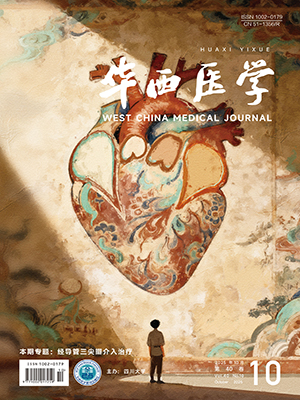| 1. |
崔秀虹, 吴耀全, 陈汉芳. 护理安全管理在产房中的应用[J]. 护理实践与研究, 2010, 7(13):63-65.
|
| 2. |
王惠. "7S"管理在产房的应用体会[J]. 护理实践与研究, 2011, 8(12):111-113.
|
| 3. |
中华人民共和国卫生部. 医院感染诊断[EB/OL]. (2001-11-07)[2015-04-03].http://www.moh.gov.cn/yzygj/s3593/200804/e19e4448378643a09913ccf2a055c79d.shtml.
|
| 4. |
中华人民共和国卫生部. 医院感染管理办法[EB/OL]. (2006-07-06)[2015-04-03]. http://www.moh.gov.cn/zhuzhan/wsbmgzl/200804/5a92cc5c37234062834ed79bb0329c3b.shtml.
|
| 5. |
中华人民共和国卫生部. 三级综合医院评审标准(2011版)[EB/OL]. (2011-04-22)[2015-04-03]. http://www.moh.gov.cn/yzygj/s3585u/201104/c6fa4cc981d4429ba8caa7666aa13710.shtml.
|
| 6. |
周军, 刘劲红, 陈黎. 发生医院感染的病历质量问题与对策[J]. 中国病案, 2011, 12(2):10-12.
|
| 7. |
尚秀娟. 医院感染管理在提高医疗质量中的重要性[J]. 中国病案, 2010, 11(2):62-64.
|
| 8. |
卢长伟, 张宏雁, 梁娜, 等. 感染管理是提高医疗质量的基础[J]. 中国卫生质量管理, 2011, 18(6):36-37.
|
| 9. |
彭检妹, 厉晓萍, 陈浪. 产房风险分级评分及风险告知在产房管理中应用的效果[J]. 中华现代护理杂志, 2010, 16(31):3813-3815.
|
| 10. |
汪颖, 邵银雪, 金和秋. 产房医院感染因素及干预措施[J]. 中华医院感染学杂志, 2014, 24(22):5660-5661, 5669.
|
| 11. |
朱丽红, 李丽, 罗志弘. 产妇医院感染分析及预防措施探讨[J]. 中华医院感染学杂志, 2014, 24(21):5383-5385.
|
| 12. |
支佩颖, 杜迎辉, 吴爱雪, 等. 产科感染因素分析与预防对策[J]. 中华医院感染学杂志, 2012, 22(12):2553-2554.
|
| 13. |
吉丽珍. 基层医院新生儿医院感染因素分析与护理对策[J]. 当代护士, 2011, 4:124-126.
|
| 14. |
杨雪华. 产科感染因素分析与预防[J]. 中国现代药物应用, 2010, 4(2):72-73.
|
| 15. |
Bhat R, Vidyasagar D. Delivery room management of meconium-stained infant[J]. Clin Perinatol, 2012, 39(4):817-831.
|
| 16. |
Aguilar AM, Vain NE. The suctioning in the delivery room debate[J]. Early Hum Dev, 2011, 87(Suppl 1):S13-S15.
|
| 17. |
王惠. 9S管理在产房感染管理中的应用[J]. 护理实践与研究, 2012, 9(4):92-93.
|
| 18. |
李兴山. 现代管理学[M]. 北京:中共中央党校出版社, 2010:49-62.
|




